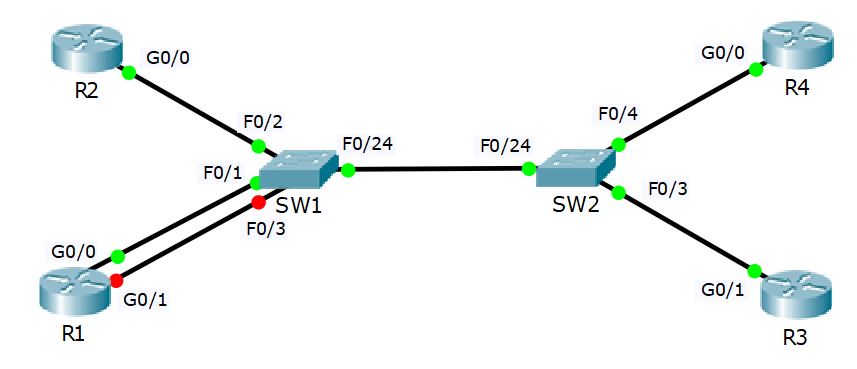< Section 10 | Home | Section 12 >
28% Complete
57: Introduction
https://www.udemy.com/cisco-icnd1/learn/lecture/8601376#content
58: Switches vs Hubs
https://www.udemy.com/cisco-icnd1/learn/lecture/8601626#content
Hubs and Switches
- Both perform a similar function
- End hosts in a Local Area Network such as PCs, Server, Printers, etc. plug into them with an Ethernet cable
- The end hosts can then communicate with each other through the hub or switch.
Hubs
- Hubs operate in Half-Duplex mode.
- Attached hosts cannot send and receive data at the same time – they can only do one or the other.
- All hosts share the same collision domain – only one device can transmit at a time.
- If two hosts send at the same time, a collision will occur.
- Hosts use Carrier-Sense Multiple Access with Collision Detection (CSMA/CD) to detect collisions and resend.
Switches
- Switches can operate in either full-duplex or half-duplex mode.
- In practice, they always operate as full-duplex.
- Attached hosts can both send and receive data at the same time.
- All hosts have their own dedicated collision domain.
- Collision Detection is NOT required.
Hubs operate at OSI Layer 1
- They are not MAC address aware
- When a frame is received, it is flooded out all ports apart from the one it was received on.
- All attached hosts must process all packets
Switches Operate on OSI Layer 2
- (They also operate on Layer 1)
- They are MAC address aware.
- When a frame is received, the switch will look at the source MAC address in in the Layer 2 Ethernet header
- The learned MAC address will be added to the switch’s MAC address table, which maps MAC addresses to ports.
- If a unicast frame is later received with a known MAC address as the destintion, the switch will send the frame to only the relevant port.
- This provides better performance and security since frames only go where they are intended,
- When a frame is received for the broadcast address or an unknown unicast destination (because the switch has not learned the MAC address yet), it will be flooded out all ports apart from the one it was received on.
59: Switch Operation
https://www.udemy.com/cisco-icnd1/learn/lecture/8601642#content
This lecture is missing ARP information!
Setup:
- PC1 MAC = 1.1.1, SwitchPort 1
- PC2 MAC = 2.2.2, SwitchPort 2
- PC3 MAC = 3.3.3, SwitchPort 3
The Story
- PC1 sends a frame to 2.2.2
- Switch receives the frame and records PC1’s MAC on Port 1 in it’s CAM (C? Accessed Memory?) table
- Switch sends the frame out all ports (Similar to an ARP) to see who responds
- PC2 Responds and the switch records PC2’s MAC for Port 2.
Note: If a port is connected to another switch, it is possible for a single port to map to multiple MAC addresses.
60: Routers
https://www.udemy.com/cisco-icnd1/learn/lecture/8601654#content
- Routers know the paths to get to the different IP subnets on a network.
- They are required when sending traffic from one subnet to another.
- Routers operate at Layer 3 of the OSI model.
- (They also operate at Layers 2 and 1 and typically have awareness up to Layer 7)
Routers vs. Switches
- Routers are Layer 3 aware and can route between different networks
- Switches are Layer 2 aware and can switch traffic between hosts on the same network
- Routers support many types of interfaces, such as Ethernet, Serial, ISDN, ADSL, etc.
- Switches typically only support Ethernet interfaces
- Switches typically have more ports than routers
- Switches forward broadcast traffic. Routers do not by default
Layer 3 Switches
- Advanced switches are Layer 3 aware and can route traffic between different IP subnets.
- Layer 3 switches will still typically support only Ethernet interfaces and will have more ports that routers.
61: Other Cisco Devices
https://www.udemy.com/cisco-icnd1/learn/lecture/8601656#content
Security
- Adaptive Security Appliance (ASA) Firewalls
- SourceFire FirePower IPS (Intrusion Prevention System)
Wireless
- Wireless LAN controllers
- Wireless Access Points
Collaboration
- Cisco Unified Communications Manager
- IP based PBX (Private Branch Exchange)
- IP Phones
- TelePresence
- Hi-def video conferencing
- WebEx
Data Center
- Cisco UCS (Unified Computing System)
- Blade Server
- Nexus Switches
- Very high end switches using a slightly different OS than IOS
62: Cisco Device Functions – Lab Exercises
https://www.udemy.com/cisco-icnd1/learn/lecture/8601764#content
11 Cisco Device Functions – Lab Exercises
